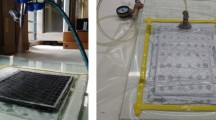Abstract
The fracture properties of commercial carbon fiber reinforced carbon (C/C) composites (CCM190C, CCM191C) that have different interfacial shear strength were investigated. Postpeak tension-softening phenomena were observed through the fracture mechanics test for these composites. The failure manner in the fracture process zone was primarily fiber pull-out for CCM190C and fiber breakage for CCM191C, respectively. It was confirmed that the scale of pseudo strain hardening for CCM190C with low interfacial shear strength was larger than that of CCM191C. The bridging energy at the postpeak part and the total energy consumed to produce a unit area of fracture surface were calculated based on the J-based technique. The bridging energy at the postpeak part accounted for 12.3% of the total energy consumed to produce a unit area of fracture surface for CCM190C. From this result, it can be deduced that the effect of the postpeak bridging energy on the fracture toughness is large for CCM190C. In contrast, the contribution of the postpeak bridging energy for the total energy per fracture surface was very small for CCM191C.
Similar content being viewed by others
References
R. A. J. Sambell, A. Briggs, D. C. Phillips and D. H. Bowen, Carbon fiber composites with ceramic and glass matrices, Part 2-continuous fibers, Journal of Material Science, 7(6) (1972) 676–681.
D. C. Phillips, The fracture energy of carbon fiber reinforced glass, Journal of Material Science, 7(10) (1972) 1175–1191.
D. C. Phillips, Interfacial bonding and the toughness of carbon fiber reinforced glass and glassceramics, Journal of Material Science, 9(11) (1974) 1847–1854.
V. C. Li and H. C. Wu, Conditions for pseudo strain-hardening in fiber reinforced brittle matrix composites, Applied Mechanics Review, 45(8) (1992) 390–398.
C. H. Hsueh and P. F. Becher, Evaluation of bridging stress from R-curve behavior for nontransforming ceramics, Journal of the American Ceramic Society, 71(5) (1988) C234–C237.
X. Z. Hu and Y. W. Mai, General method for determination of crack interface bridging stresses, Journal of Material Science, 27 (1992) 3502–3510.
V. C. Li, Fracture resistance parameters for cementitious materials and their experimental determination, Application of Fracture Mechanics to Cementitious Composites, Edited by S. P. Shah, Marinus Nijhoff Publishers, Dordrecht, Netherlands, (1985) 431–449.
V. C. Li, C. M. Chan and C. K. Y. Leung, Experimental determination of the tension-softening curve in cementitious composites, Cement and Concrete Research, 17(3) (1987) 441–452.
Stress Intensity Factors Handbook, Edited by Y. Murakami et al., Pergamon, Oxford, 1 (1987) 24–25.
A. Saxena and S. J. Hudak, Jr., Review and extension of compliance information for common crack growth specimens, International Journal of Fracture Mechanics, 14(5) (1978) 453–468.
Tension testing of metallic materials, ASTM E 8, (2004).
T. Hashida, V. C. Li and H. Takahashi, New development of the J-based fracture testing technique for ceramic-matrix composites, Journal of the American Ceramic Society, 77(6) (1994) 1553–1561.
Author information
Authors and Affiliations
Corresponding author
Additional information
This paper was recommended for publication in revised form by Associate Editor Chongdu Cho
Yonjig Kim received B. S. and M. S. degrees in Mechanical Design Engineering and Mechanical Engineering at Chonbuk National University in 1983 and 1985, respectively. He enlisted in the army as a soldier and leaved the army in 1988, and then got a ph. D. degree in Mechanical Engineering at Chonbuk National University in 1993. Dr. Kim is currently working as a professor in his alma mater, Chonbuk National University. His major area of study is materials and fracture mechanics and he is interested mainly in fracture of fiber reinforced polymer composites.
Rights and permissions
About this article
Cite this article
Kim, Y. Effect of postpeak tension-softening behavior on the fracture properties of 2-D carbon fiber reinforced carbon composite. J Mech Sci Technol 23, 8–13 (2009). https://doi.org/10.1007/s12206-008-0929-0
Received:
Revised:
Accepted:
Published:
Issue Date:
DOI: https://doi.org/10.1007/s12206-008-0929-0




